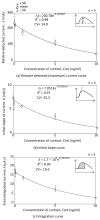Immunosensor with fluid control mechanism for salivary cortisol analysis
- PMID: 22939507
- PMCID: PMC3525717
- DOI: 10.1016/j.bios.2012.08.016
Immunosensor with fluid control mechanism for salivary cortisol analysis
Abstract
The purpose of this research is to demonstrate a new design for a cortisol immunosensor for the noninvasive and quantitative analysis of salivary cortisol. We propose a cortisol immunosensor with a fluid control mechanism which has both a vertical flow and a lateral flow. The detected current resulting from a competitive reaction between the sample cortisol and a glucose oxidase (GOD)-labeled cortisol conjugate was found to be inversely related to the concentration of cortisol in the sample solution. A calibration curve using the relative detected current showed a R(2)=0.98 and CV=14% for a range of standard cortisol solutions corresponding to the concentrations of native salivary cortisol (0.1-10 ng/ml). The measurement could be accomplished within 35 min and the cortisol immunosensor could be reused. These results show promise for realizing an on-site and easy-to-use biosensor for cortisol. Used for evaluation of human salivary cortisol levels, the cortisol immunosensor measurement corresponded closely with commercially available ELISA method (R(2)=0.92). Our results indicate the promise of the new cortisol immunosensor for noninvasive, point of care measurement of human salivary cortisol levels.
Copyright © 2012 Elsevier B.V. All rights reserved.
Figures






Similar articles
-
A simple and compact smartphone accessory for quantitative chemiluminescence-based lateral flow immunoassay for salivary cortisol detection.Biosens Bioelectron. 2015 Feb 15;64:63-8. doi: 10.1016/j.bios.2014.08.048. Epub 2014 Aug 23. Biosens Bioelectron. 2015. PMID: 25194797
-
Automated-immunosensor with centrifugal fluid valves for salivary cortisol measurement.Sens Biosensing Res. 2014 Aug;1:15-20. doi: 10.1016/j.sbsr.2014.07.001. Epub 2014 Jul 9. Sens Biosensing Res. 2014. PMID: 26543818 Free PMC article.
-
Dithiobis(succinimidyl propionate) modified gold microarray electrode based electrochemical immunosensor for ultrasensitive detection of cortisol.Biosens Bioelectron. 2010 Jun 15;25(10):2296-301. doi: 10.1016/j.bios.2010.03.016. Epub 2010 Mar 18. Biosens Bioelectron. 2010. PMID: 20382518 Free PMC article.
-
Materials for Microfluidic Immunoassays: A Review.Adv Healthc Mater. 2017 Aug;6(15). doi: 10.1002/adhm.201601403. Epub 2017 Mar 21. Adv Healthc Mater. 2017. PMID: 28322517 Review.
-
Salivary cortisol and cortisone in the clinical setting.Curr Opin Endocrinol Diabetes Obes. 2017 Jun;24(3):161-168. doi: 10.1097/MED.0000000000000328. Curr Opin Endocrinol Diabetes Obes. 2017. PMID: 28375882 Review.
Cited by
-
Emerging Dual-Gate FET Sensor Paradigm for Ultra-Low Concentration Cortisol Detection in Complex Bioenvironments.Biosensors (Basel). 2025 Feb 22;15(3):134. doi: 10.3390/bios15030134. Biosensors (Basel). 2025. PMID: 40136931 Free PMC article.
-
Selective Amplification of Plasmonic Sensor Signal for Cortisol Detection Using Gold Nanoparticles.Biosensors (Basel). 2022 Jul 1;12(7):482. doi: 10.3390/bios12070482. Biosensors (Basel). 2022. PMID: 35884285 Free PMC article.
-
Cortisol AuPd plasmonic unclad POF biosensor.Biotechnol Rep (Amst). 2021 Jan 6;29:e00587. doi: 10.1016/j.btre.2021.e00587. eCollection 2021 Mar. Biotechnol Rep (Amst). 2021. PMID: 33489788 Free PMC article.
-
Electrochemical sensing of cortisol: a recent update.Appl Biochem Biotechnol. 2014 Oct;174(3):1115-26. doi: 10.1007/s12010-014-0894-2. Epub 2014 Apr 11. Appl Biochem Biotechnol. 2014. PMID: 24723204 Free PMC article. Review.
-
Saliva-based biosensors: noninvasive monitoring tool for clinical diagnostics.Biomed Res Int. 2014;2014:962903. doi: 10.1155/2014/962903. Epub 2014 Sep 8. Biomed Res Int. 2014. PMID: 25276835 Free PMC article. Review.
References
Publication types
MeSH terms
Substances
Grants and funding
LinkOut - more resources
Full Text Sources
Other Literature Sources

